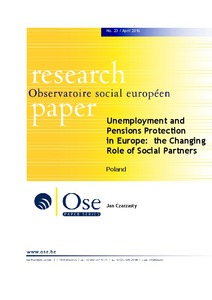Unemployment and pensions protection in Europe: the changing role of social partners - Poland
"Occupational Welfare (OW) is a peripheral phenomenon in Poland. Following the collapse of authoritarian state socialism in 1989, the ‘welfare-providing workplace’ – a workplace whose scope of responsibilities included welfare provision to employees (in which process trade unions played a vital...
| Main Author: | |
|---|---|
| Institution: | ETUI-European Trade Union Institute |
| Format: | TEXT |
| Language: | English |
| Published: |
Brussels
2016
OSE |
| Subjects: | |
| Online Access: | https://www.labourline.org/KENTIKA-19104286124919224689-unemployment-and-pensions-prot.htm |
| Summary: | "Occupational Welfare (OW) is a peripheral phenomenon in Poland. Following the collapse of authoritarian state socialism in 1989, the ‘welfare-providing workplace’ – a workplace whose scope of responsibilities included welfare provision to employees (in which process trade unions played a vital role) – disappeared. From 1990 onwards, OW has been evolving in a largely decentralized and uncoordinated manner. The most significant type of OW are company social funds (zak?adowe fundusze ?wiadcze? socjalnych, ZF?S), which must be established for most employers (but can be legally avoided), followed by optional schemes related to healthcare provision, and group casualty insurance.
This limited spread of occupational schemes is confirmed by an analysis of pensions and unemployment benefits. Despite the introduction of a three pillar pensions system in 1999, occupational pensions (the 3rd pillar) have grown to cover only a tiny share of the workforce (slightly over 3%). Between 2011 and 2014 the pensions system was largely dismantled: first by limiting the role of the 2nd pillar (mandatory private), secondly by raising the retirement age (to 67), and finally, by the de facto ‘nationalisation’ of the vast majority of the assets in the 2nd pillar (transferred to the 1st pillar, i.e. mandatory public). In early 2016, the possibility of returning to the former retirement age (separately defined for women and men) is under debate. Unemployment protection is very limited, no unemployment insurance exists, and unemployment benefits are not income-related. " |
|---|---|
| Physical Description: | 47 p. Digital |

